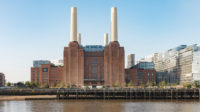For more than two decades, the Battersea coal-fired power station, rumored to be the largest brick building in Europe, has sat dormant on the south bank of River Thames in London. The facility, built in 1939, was designed by Sir Giles Gilbert Scott, the architect responsible for the city’s iconic red telephone booths and the Bankside power station, which, in 2000, Herzog & de Meuron converted into the Tate Modern. Since the Battersea plant stopped producing electricity in 1983, developers have proposed various schemes for the beleaguered site—amusement parks and cultural centers, among them— but none has managed to leave the drawing board.
Once again, there is talk of resurrecting the site. In June, Rafael Viñoly Architects and Real Estate Opportunities (REO) unveiled an 8-million-square-foot master plan for the 38-acre property. Viñoly—who reportedly beat out Norman Foster and Skidmore, Owings & Merrill for the commission—envisions transforming the 70-year-old power station into a mixed-use complex. The boiler house would contain residential units and a hotel, the old control room will be converted into an energy museum, and the defunct turbine halls would be filled with shops and public spaces. The scheme also calls for new construction around the power station, most notably an office campus that would be covered by a so-called Eco-Dome made of ETFE, similar to The Eden Project by Nicholas Grimshaw. Rising from the dome would be a 1,000-tall glass tower containing residential units. This tower would serve as a chimney, drawing warm air out of the campus.
Altogether, Viñoly’s Battersea scheme contains 3 million square feet worth of residential program, 2.5 million square feet for offices, 900,000 square feet for retail, and a considerable amount of space for leisure, cultural, and community venues. A six-acre public park and riverside walkway are also included in the design. The developer says it’s discussing with the city the possibility of extending a subway line to the area. “It’s so close to everything in the city,” explains Viñoly, “yet it is so far, in terms of serviceability because of horrendous public transportation at the site.”
Viñoly aims for the Battersea development to be a model for sustainable design, noting that he’s received clear direction from the owner to go beyond the “PR approach to sustainability, where you satisfy your conscience with a few devices that achieve a certain degree of sustainability.” The complex, intended to be carbon neutral, will have its own “energy center,” which will generate power using renewable resources. “We are trying to create a solution, to get to the mothership of sustainability,” Viñoly says.
The scheme was on view at the site through the summer, and drew more than 15,000 visitors. REO distributed a survey about the project and says 67 percent of respondents say they approve of the plan. The proposal has incited a torrent of feedback, taking a turn for the shrill when George Ferguson, former president of the Royal Institute of British Architects, called it “a major menace to London.” Some critics complain that the scheme is unattractive and doesn’t respect the historic architecture. Viñoly says for the project to succeed, the dome and tower are essential to achieving the intended sustainability goals. “This goes beyond a discussion of whether you like the look or not,” he says. “It raises an issue with the overall agenda of sustainability.”
Presently, the project is in the public review stage and will be submitted to city planners for approval early next year, with completion scheduled for 2020. Of course, given the global economic crisis, the project—expected to cost around $6 billion (4 billion pounds)—could face funding challenges. In November, Ian Lindsley, a project spokesman, said they are holding off on pursuing financing for now. “The planning process is likely to take two years,” he says, “by which time the property market should look different from today.”
Correction: Due to a typing error, we incorrectly stated that the project is expected to cost 4 million pounds instead of 4 billion pounds.






Post a comment to this article
Report Abusive Comment